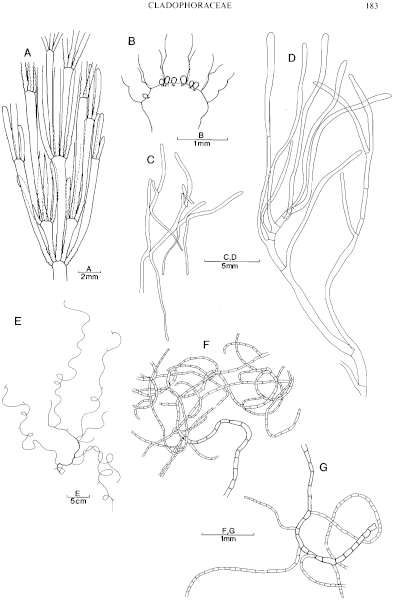|
|
|
|
|
|||||||||||
|
Electronic Flora of South Australia Species Fact Sheet
Phylum Chlorophyta – Order Cladophorales – Family Cladophoraceae
Thallus (Fig. 60A) medium to dark green, forming indefinite hair-like masses of more or less curving, intertwined filaments (Fig. 59E), often entangled with other, larger algae; filaments long, unbranched or with scattered curved branchlets (Fig. 59F), regenerating thick-walled akinete filaments with more numerous laterals (Fig. 59G). Growth by frequent intercalary divisions; angle of branching usually wide (about 90°), with scattered cells bearing one lateral; insertion of branches usually with vertical to steeply inclined walls, partly subterminal (Fig. 59F). Apical cells slightly tapering with rounded tips. A tendency for inversion of polarity results sometimes in the outgrowth of branches from opposite cell poles within one and the same akinete filament. Rhizoids were not observed; the entangled growth habit seems to ensure attachment to other algae.
Apical cells 24–30 µm in diameter, L/B 2–4, increasing only slightly to main filaments with cells 40–50 µm in diameter and L/B 2.5–7; ratio of main filament cell to apical cell diameters 1.3–2; the scattered akinete filaments 50–120 µm in diameter with L/B 2–5; cell walls relatively thin, 1–2 in actively growing parts to 5–15 µm in akinetes (Fig. 59G).
Reproduction: Reproduction unknown, possibly by fragmentation of akinete filaments.
Type from Nora Creina, S.Aust., drift on Seirococcus in pool (Womersley, 31.xii.1981). Holotype: ADU, A52833. Isotype in GRO.
Distribution: Apart from the type, known from Georgetown, Tas. (Perrin, April, 1932; HO, 44866; herb. Sonder in MEL, 597510 and 597511).
Taxonomic notes: Cl. rhizoclonioidea is distinguished by its curved filaments and Rhizoclonium-like habit, and by its scattered branches with lateral insertion. It much resembles the European freshwater species Cl. rivularis (L.) van den Hoek (1963, p. 113).
References:
VAN DEN HOEK, C. (1963). Revision of the European species of Cladophora. (Brill: Leiden.)
The Marine Benthic Flora of Southern Australia Part I complete list of references.
Publication:
Womersley, H.B.S. (31 May, 1984)
The Marine Benthic Flora of Southern Australia
Part I
©Board of the Botanic Gardens and State Herbarium, Government of South Australia
Illustration in Womersley Part I, 1984: FIGS 59 E–G, 60A.

Figure 59 enlarge
Fig. 59. A,B. Apjohnia laetevirens (ADU, A27299). A. A branch with series of basally annulate segments. B. Lower cells with annular constrictions and hapteroid cells. C. Cladophoropsis herpestica (ADU, A13612). Filaments with descending rhizoids and open connection to lateral branches. D. Cladophoropsis magna (Type). A cluster of filaments showing branches in open connection to lower cells. E–G. Cladophora rhizoclonioidea (Holotype). E. Habit. F. A group of entangled filaments. G. An old regenerating filament with young lateral branches.

|
Email Contact: State Herbarium of South Australia |

|